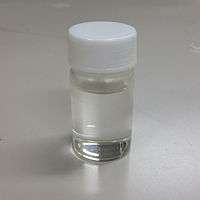Titanium isopropoxide
4.png) | |
 | |
| Names | |
|---|---|
| IUPAC name
Titanium isopropoxide | |
| Other names
Tetraisopropyl titanate Titanium(IV) i-propoxide Titanium tetraisopropoxide Tetraisopropyl orthotitanate | |
| Identifiers | |
| 546-68-9 | |
| 3D model (Jmol) | Interactive image |
| ECHA InfoCard | 100.008.100 |
| PubChem | 11026 |
| |
| |
| Properties | |
| C12H28O4Ti | |
| Molar mass | 284.215 g/mol |
| Appearance | colorless to light-yellow liquid |
| Density | 0.96 g/cm3 |
| Melting point | 17 °C (63 °F; 290 K) approximation |
| Boiling point | 232 °C (450 °F; 505 K) |
| Reacts to form TiO2 | |
| Solubility | soluble in ethanol, ether, benzene, chloroform |
| Refractive index (nD) |
1.46 |
| Hazards | |
| Lethal dose or concentration (LD, LC): | |
| LD50 (median dose) |
7600 mg/kg (rat, oral) |
| Related compounds | |
| Other cations |
Aluminium isopropoxide |
| Except where otherwise noted, data are given for materials in their standard state (at 25 °C [77 °F], 100 kPa). | |
| | |
| Infobox references | |
Titanium isopropoxide, also commonly referred to as titanium tetraisopropoxide or TTIP, is a chemical compound with the formula Ti{OCH(CH3)2}4. This alkoxide of titanium(IV) is used in organic synthesis and materials science. It is a diamagnetic tetrahedral molecule.
The structures of the titanium alkoxides are often complex. Crystalline titanium methoxide is tetrameric with the molecular formula Ti4(OCH3)16.[1] Alkoxides derived from bulkier alcohols such as isopropanol aggregate less. Titanium isopropoxide is mainly a monomer in nonpolar solvents.[2]
Preparation
It is prepared by treating titanium tetrachloride with isopropanol. Hydrogen chloride is formed as a coproduct:[2]
- TiCl4 + 4 (CH3)2CHOH → Ti{OCH(CH3)2}4 + 4 HCl
Properties
Titanium isopropoxide reacts with water to deposit titanium dioxide:[3]
- Ti{OCH(CH3)2}4 + 2 H2O → TiO2 + 4 (CH3)2CHOH
This reaction is employed in the sol-gel synthesis of TiO2-based materials in the form of powders or thin films. Typically water is added in excess to a solution of the alkoxide in an alcohol. The composition, crystallinity and morphology of the inorganic product are determined by the presence of additives (e.g. acetic acid), the amount of water (hydrolysis ratio), and reaction conditions.[3]
Titanium isopropoxide is a component of the Sharpless epoxidation, a method for the synthesis of chiral epoxides. The compound is also used as a catalyst for the preparation of certain cyclopropanes in the Kulinkovich reaction. Prochiral thioethers are oxidized enantioselectively using a catalyst derived from Ti(O-i-Pr)4.[4]
Naming
Titanium(IV) isopropoxide is a widely used item of commerce and has acquired many names in addition to those listed in the table. A sampling of the names include: titanium(IV) i-propoxide, isopropyl titanate, tetraisopropyl titanate, tetraisopropyl orthotitanate, titanium tetraisopropylate, orthotitanic acid tetraisopropyl ester, Isopropyl titanate(IV), titanic acid tetraisopropyl ester, isopropyltitanate, titanium(IV) isopropoxide, titanium tetraisopropoxide, iso-propyl titanate, titanium tetraisopropanolate, tetraisopropoxytitanium(IV), tetraisopropanolatotitanium, tetrakis(isopropoxy) titanium, tetrakis(isopropanolato) titanium, titanic acid isopropyl ester, titanic acid tetraisopropyl ester, titanium isopropoxide, titanium isopropylate, tetrakis(1-methylethoxy)titanium.
References
- ↑ see Wright D. A.; Williams, D. A. “The Crystal and Molecular Structure of Titanium Tetramethoxide” Acta Crystallographica 1968, Volume B24, pages 1107-1114. doi:10.1107/S0567740868003766
- 1 2 Bradley, D. C.; Mehrotra, R.; Rothwell, I.; Singh, A. “Alkoxo and Aryloxo Derivatives of Metals” Academic Press, San Diego, 2001. ISBN 0-12-124140-8.
- 1 2 Hanaor, D.A.H.; Chironi, I.; Karatchevtseva, I.; Triani, G.; Sorrell, C.C. (2012). "Single and Mixed Phase TiO2 Powders Prepared by Excess Hydrolysis of Titanium Alkoxide". Advances in Applied Ceramics. 111 (3): 149–158. doi:10.1179/1743676111Y.0000000059.
- ↑ S. H. Zhao, O. Samuel, H. B. Kagan “Enantioelective Oxidation of a Sulfide:: (S)-(−)-Methyl p-Tolyl Sulfoxide” Organic Syntheses, Collected Volume 8, p.464 (1993).http://www.orgsyn.org/orgsyn/pdfs/CV8P0464.pdf